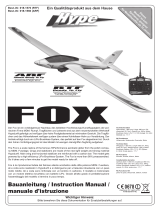14
• Move rudder stick left --> rudder must de! ect
to the left
• Throttle (motor) stick forward --> Motor speed
must rise
• Throttle (motor) stick back --> Motor speed
must fall
If any control function works in the wrong direction, you
must reverse the corresponding channel to correct it. If
you are not sure how to do this, refer to the operating
instructions supplied with your radio control system.
When the tailplane is in the neutral position, you will be
able to see a socket-head screw through the small hole
at the rear on the left-hand side: this indicates the neutral
position of the all-moving tailplane. If that is not the case,
use the allen key 11 (supplied) to correct the position.
4: Setting the control surface travels (pic. 12 a&b):
It is important to set the control surface travels correctly,
as these settings have a crucial in! uence on the mod-
el’s overall control response. In all cases the travels are
measured at the point of maximum chord (width of control
surface.
The control surface travels can be measured using a
geometry set-square. Measure the travels at the trailing
edge of each panel, starting from the neutral position.
The control surface travels should be as follows:
Elevator
up - stick back - approx. + 10 mm
down - stick forward - approx. - 10 mm
Rudder
left and right each way - approx. 13 mm
when you have completed this stage, disconnect the ! ight
battery again, and recharge it. Observe the instructions
supplied with your battery charger.
5: Fitting the wings (pic. 14&14):
Take the left-hand wing panel 3 and the right-hand wing
panel 4, and " t them together Attach this assembly to the
fuselage using the plastic screw 7 and the screwdriver 10.
Don’t over-tighten the screw; hand-tight is quite suf" cient.
Check that the wings are positioned correctly.
6: Balancing (pic. 15):
To make your SHARK ! y safe and stable it must be bal-
anced at the correct point or C.G. (Centre of gravity) - just
like every other aircraft. Assemble your model completely,
ready to ! y. Place the ! ight battery in the nose of the
fuselage (don’t connect it at this stage), and place the
canopy on the model.
Locate the raised points under each wing root, place both
index " ngers on those points, and raise the model: the
model should now balance level, ideally with the nose
inclined slightly down. If so, then the model is balanced
correctly. If you need to adjust the balance point (CG),
move the ! ight battery slightly forward or back. When the
position is correct, mark the battery position inside the
fuselage with a felt-tip pen.
The Centre of Gravity (CG) of the SHARK is located 27
mm aft of the rear edge of the tubular aluminium spar.
If you can not reach the center of gravity by positioning
the RC equipment, a correction is possible with ballast.
7. Upgrading:
7.1 Aileron upgrade (pic. 16&17):
The model is designed for aileron control. For this you
require the optional upgrade set # 6 5165. Using a sharp
balsa knife, carefully cut through both ends of the aileron
to allow it to de! ect up and down; check that the ends do
not rub on the wing. Carefully cut through the SHARK
sticker on the underside of the wing, and fold it back on
itself: under the sticker you will " nd a recess which " ts the
Nano-S or Ms-12015 servo. Centre the servo from your
transmitter, push it into the recess, and glue it to the foam
by applying a small drop of Zacki # 85 2727 to each servo
lug. Press the cable into the channel, and apply small
pieces of adhesive tape over the slot to prevent it working
loose. Now cut a slot in the SHARK sticker to allow the
servo output arm to move freely in both directions. Glue
the horn in the appropriate recess in the aileron. Connect
the pre-formed wire pushrod to the servo output arm, and
slip the other end through the swivel connector. Check
that the servo and the aileron are both at centre (neutral)
before tightening the clamping screw using the allen key
11. Repeat the procedure with the other wing.
The ailerons must be set up in such a way that the right-
hand aileron de! ects up, and the left-hand aileron de! ects
down, when the aileron stick is moved to the right.
The travels should be approximately:
Ailerons
up - approx. + 13 mm
down - approx. - 9 mm
7.2 Undercarriage and ! oats (pic. 18-21):
Simply insert the undercarriage # 22 4327 or the ! oats
assembly # 22 4328 in the slot on the underside of the
fuselage until it audibly “CLICKS” into place. To remove
it again, locate the internal lug between the two control
“snakes”, and pull it gently towards you: the undercarriage
/ ! oats assembly can now be withdrawn.
CAUTION: when the ! oats are " tted, the Centre of
Gravity should be at a point 2 mm aft of the rear edge
of the tubular aluminium spar.











